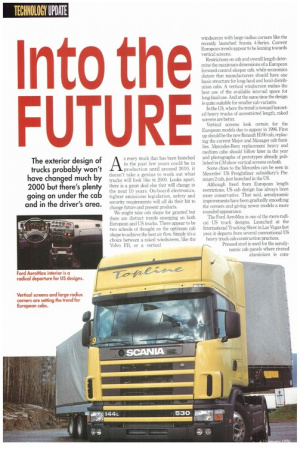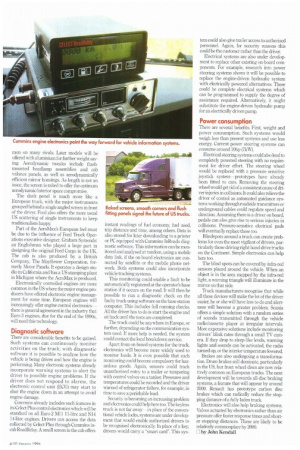Into the FUTLJ
Page 28

Page 29

If you've noticed an error in this article please click here to report it so we can fix it.
As every truck that has been launched in the past few years could be in production until around 2010, it doesn't take a genius to work out what trucks will look like in 2000. Looks apart, there is a great deal else that will change in the next 10 years. On-board electronics, tighter emissions legislation, safety and security requirements will all do their bit to change future and present products.
We might take cab shape for granted but there are distinct trends emerging on both European and US trucks. There appear to be two schools of thought on the optimum cab shape to achieve the best airflow. Simply it's a choice between a raked windscreen, like the Volvo FH, or a vertical windscreen with large radius corners like the recently launched Scania 4-Series. Current European trends appear to be leaning towards vertical screens.
Restrictions on cab and overall length determine the maximum dimensions of a European forward-control sleeper cab, while economics dictate that manufacturers should have one basic structure for long-haul and local-distribution cabs. A vertical windscreen makes the best use of the available internal space for long-haul use. And at the same time the design is quite suitable for smaller cab variants.
In the US, where the trend is toward bonneted heavy trucks of unrestricted length, raked screens are better.
Vertical screens look certain for the European models due to appear in 1996. First up should be the new Renault 11100 cab, replacing the current Major and Manager cab families. Mercedes-Benz replacement heavy and medium cabs should follow later in the year and photographs of prototypes already published in CM show vertical screens on both.
Some clues to the Mercedes can be seen in Mercedes' US Freightliner subsidiary's Premium 2 cab, just launched in the US.
Although freed from European length restrictions, US cab design has always been more conservative. That said, aerodynamic improvements have been gradually smoothing the corners and giving newer models a more rounded appearance.
The Ford AeroMax is one of the more radical US truck designs. Launched at the International Trucking Show in Las Vegas last year, it departs from several conventional US
heavy truck cab construction practices.
Pressed steel is used for the aerodynamic cab panels where riveted aluminium is corn mon on many rivals. Later models will be offered with aluminium for further weight saving. Aerodynamic tweaks include flushmounted headlamp assemblies and cab valance panels, as well as aerodynamically efficient mirror housings. As length is not an issue, the screen is raked to offer the optimum aerodynamic/interior space compromise.
The dash panel is much more like a European truck, with the major instruments grouped behind a single angled screen in front of the driver. Ford also offers the more usual US scattering of single instruments to keep traditionalists happy.
Part of the AeroMax's European feel must be due to the influence of Ford Truck Operations executive designer, Graham Symonds: an Englishman who played a large part in designing the original Ford Cargo in the UK. The cab is also produced by a British Company, The Mayflower Corporation, formerly Motor Panels. It operates a design studio in California and has a US stamping plant in Michigan where the AeroMax is produced.
Electronically controlled engines are more common in the US where the major engine producers have offered electronic engine management for some time. European engines will increasingly offer engine control electronicsthere is general agreement in the industry that Euro-3 engines, due for the end of the 1990s, will need this technology
Diagnostic software
There are considerable benefits to be gained. Such systems can continuously monitor activities on the truck: with diagnostic software it is possible to analyse how the vehicle is being driven and how the engine is performing Many electronic systems already incorporate warning systems to alert the driver to possible engine problems. lithe driver does not respond to alarms, the electronic control unit (ECU) may start to shut the engine down in an attempt to avoid engine damage.
Cummins already includes such features in its Celect Plus control electronics which will be standard on all Euro-2 M1 1 11-litre and N14 14-litre engines. Drivers can access the data collected by Celect Plus through Cummins incab RoadRelay. A small screen in the cab offers instant readings of fuel economy, fuel used, trip distance and time, among others. Data is also stored for later downloading to a printer or PC equipped with Cummins InRoads diagnostic software. This information can be monitored and analysed at random, using a mobile data link, if the on-board electronics are connected by satellite or the mobile phone network. Both systems could also incorporate vehicle tracking systems.
This monitoring could enable a fault to be automatically registered at the operator's base station if it occurs on the road. It will then be possible to run a diagnostic check on the faulty truck using software on the base station computer. This includes full running checks. All the driver has to do is start the engine and sit back until the tests are completed.
The truck could be anywhere in Europe, or further, depending on the communication system used. If more help is needed, the system could contact the local breakdown service.
Apart from on-board systems for the truck, electronics will become more widely used to monitor loads. It is even possible that such monitoring could become compulsory for hazardous goods. Again, sensors could track unauthorised entry to a trailer or tampering with control valves on a tanker. Pressures and temperatures could be recorded and the driver warned of refrigerator failure, for example, in time to save a perishable load.
Security is becoming an increasing problem and electronics could help here too. The keyless truck is not far away in place of the conventional vehicle locks, systems are under development that would enable authorised drivers to be recognised electronically. In place of a key, drivers would carry a "smart card". This sys
tern could also give trailer access to authorised personnel. Again, for security reasons this could be the customer rather than the driver.
Electrical systems are also under development to replace other existing on-board components. For example, research into power steering systems shows it will be possible to replace the engine-driven hydraulic system with electrically powered alternatives. These could be complete electrical systems which can be programmed to supply the degree of assistance required. Alternatively, it might substitute the engine-driven hydraulic pump for an electrically driven pump.
Power consumption
There are several benefits. First, weight and power consumption. Such systems would weigh less than present systems and use less energy Current power steering systems can consume around 10hp (7kW).
Electrical steering systems could also lead to completely powered steering with no requirement for driver effort. The steering wheel would be replaced with a pressure sensitive joystick system—prototypes have already been fitted to cars. Removing the steering wheel would get rid of a consistent cause of driver injuries in collisions. It could also relieve the driver of control as automated guidance systems working through roadside transmitters or underground cables could regulate speed and direction_ Assuming there is a driver on board, pedals can also give rise to serious injuries in collisions. Pressure-sensitive electrical pads will eventually replace these too.
Blindspots around a truck can create problems for even the most vigilant of drivers, particularly those driving right-hand-drive trucks on the Continent. Simple electronics can help here too.
The blind spots can be covered by infra-red sensors placed around the vehicle. When an object is in the area mapped by the infra-red light, a warning triangle will illuminate in the mirror on that side.
Truck manufacturers recognise that while all these devices will make the lot of the driver easier, he or she will have less to do and alertness will become a greater problem. Scania offers a simple solution with a random series of sounds transmitted through the vehicle radio/cassette player at irregular intervals. More expensive solutions include monitoring drivers' blink rates through a small TV camera. If they drop to sleep-like levels, warning lights and sounds can be activated, the radio turned up, or the interior temperature lowered.
Brakes are also undergoing a transformation. Drum brakes still dominate, particularly in the US, but front wheel discs are now relatively common on European trucks. The next development will be towards all-disc braking systems, a feature that will appear by around 2000. Renault has prototype carbon disc brakes which can radically reduce the stopping distance of a fully laden truck.
Electronics will also help braking systems. Valves actuated by electronics rather than air pressure offer faster response times and shorter stopping distances. These are likely to be relatively commonplace by 2000.
El by John Kendall




















































































